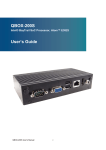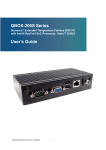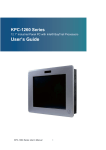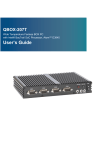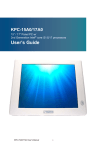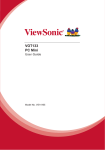Download Foxconn nT-A3550
Transcript
nT-A3000 Series Nettop User’s Manual Trademark: All trademarks are the property of their respective owners. Version: User’s Manual V1.0 for nT-A3000 Series Nettop. P/N: 3A223A900-000-G CA UT IO N Symbol description: ! Caution : refers to important information that can help you to use NETTOP better, and tells you how to avoid problems. WEEE: The use of this symbol indicates that this product may not be treated as household waste. By ensuring this product is disposed of correctly, you will help prevent potential negative consequences for the environment and human health, which could otherwise be caused by inappropriate waste handling of this product. For more detailed information about recycling of this product, please contact your local city office, your household waste disposal service or the shop where you purchased this product. CAUTION RISK OF EXPLOSION IF BATTERY IS REPLACED BY AN INCORRECT TYPE DISPOSE OF USED BATTERIES ACCORDING TO THE INSTRUCTIONS © All rights reserved. All trade names are registered trademarks of respective manufacturers listed. All images are for reference only, please refer to the physical product for specific features. CA UT IO N Safety Notice : ! Before using this product, please read the below safety notice carefully, this will help to extend the product’s lifecycle, and work normally. ■ When NETTOP is working, please make sure its ventilation system is working. ■ The power adapter is dissipating heat during normal use, please be sure not to cover it and keep it away from your body to prevent discomfort or injury by heat exposure. ■ Please use the power adapter that comes with the product’s package, wrong power adapter may damage your device. ■ Make sure all the peripherals are properly connected before using NETTOP. ■ This product should only be used in an environment with ambient temperatures between 0◦C and 40◦C. ■ To reduce the risk of fire, use only No. 26 AWG or larger UL listed or CSA certified telecommunication line cord. ■ Always shut down the computer before installing or uninstalling the peripheral which does not support hot plug. ■ Disconnect all peripherals before servicing or disassembling this equipment. ■ Please do not disassemble this product by yourself, any disassembly not approved by the original manufacturer may result in malfunction, and void warranty. ■ Risk of explosion if battery is replaced by an incorrect type, please dispose of used batteries according to the instructions. Table of Contents Chapter 1 Introducing the NETTOP Top ���� View....................................................................................................2 Front Side ���� View.........................................................................................2 Back Side ���� View.........................................................................................3 ............ Bottom View..............................................................................................3 Chapter 2 Placing and connecting the NETTOP Placement of NETTOP On the Desk..........................................................................................5 On the Display Back..............................................................................5 Connection of NETTOP�� Connect the Monitor..............................................................................7 ������� Connect ����������������������� the ����������� USB Devices.....................................................................7 Connect ������������������������� the ������������� Network Cable..................................................................8 Connect ���������������������� the ���������� Power Cord.......................................................................8 Chapter 3 BIOS Setup Enter BIOS Setup....................................................................................10 Main ....................................................................................................... 11 Advanced................................................................................................13 Boot.........................................................................................................15 Security...................................................................................................17 Save & Exit..............................................................................................18 Chapter 4 Install Windows 7 in NETTOP Install Windows 7....................................................................................21 Install Drivers in Windows 7....................................................................25 Accessory List Thanks for choosing our products. Please check the accessories listed below. If there is anything broken or lost, please contact with your distributors as soon as possible. DVI to VGA Adapter Power Adapter Power Cord magnet rubber foot Vesa mount Seatbase Opening Tool Mini PCIe Half Card Support Screw Cover Screw for VESA Mounting (M8.0X9.7mm)(4X) Screw for HDD Support Bracket (M:4.7X2.85mm)(4X) 2.43mm 4.40mm 4.85mm Screw for Half MiniPCI Half Card Support Bracket (M:4.4X4.85mm)(1X) 2.42mm 2.85mm 4.40mm 2.92mm 4.70mm 3.90mm 8.00mm 9.70mm 2.85mm Screw for Half MiniPCI Card (M:4.4X2.85mm)(1X) This chapter introduces NETTOP’s outlook : ■ Top View ■ Front Side View ■ Back Side View ■ Bottom View 1-1 Top View 1 190mm 1 135mm No. 1 Name Description Kensington Lock Attach a Kensington security system or a compatible lock to secure your Nettop 1-2 Front Side View 24mm 1 2 3 4 5 6 No. Name Description 1 Headphone Port Connects to a headphone 2 Microphone In and S/PDIF In Port Connects to a microphone or playback devices with optical connectors(3.5mm jack) 3 Multi-Function Card Reader Support SD/SDHC/MS/MS Pro/MMC memory cards 4 USB 3.0 Ports Connect to USB devices Caution:Before using it, you need to install the “ASMedia USB3.0 driver” in the Driver CD. 5 Suspend Button Enter suspend mode in operating system 6 Power Button with Integrated LED Indicator Turning the power on/off, Indicates ����������������������� system states 1-3 Back Side View 1 2 1 3 4 5 6 No. Name Description 1 USB 2.0 Ports Connects to USB devices 2 Display Output Port Connects to display device 3 HDMI Port Connects to HDMI audio and video 4 Network Port Standard RJ-45 network port 5 Line Out and S/PDIF Out Port Connects to powered analog speakers or recording devices with optical connectors(3.5mm jack) 6 Power Input Port Connects to the power adapter 1-4 Bottom View 1 No. 1 CA UT IO N ! Name Description Sheet Metal NETDVD(optional accessary) or Magnet-Metal-Feet can magnetize them to seat firmly There are four Magnet-Metal-Feet in the package. Just align them to the sheet metal on the bottom, then they can magnetize the NETTOP easily. The feet can seat and protect NETTOP when it is placed on the tabletop. In this chapter, the placement and the connection of some necessary peripherals will be introduced. This chapter includes the following information: ■ Placement of NETTOP ■ Connection of NETTOP 2-1 Placement of NETTOP 1. On the Desk 1.1.You can install your NETTOP in the mount like the right image. 2 1.2. If there is enough space on your desk, you can simply put your NETTOP on the tabletop as shown below. 2. On the Display Back CA UT IO N This is the best space-saving way. 2.1. Use four screws to fasten the bracket onto the display back. ! To install this bracket, your display must follow VESA75/VESA100 standard. The two groups of holes on your dispaly have different space between, and they help you easily fasten the bracket onto your display. 2 2.2. Fit the NETTOP into the bracket with power button locating at the top for easy touch. 2 CA UT IO N 1 ! Lift up the NETTOP straightly to take it out. 2-2 Connection of NETTOP 1. Connect the Monitor Connect a monitor to the NETTOP through DVI connector. 2 2. Connect the USB Devices Connect USB devices to the USB ports of the NETTOP, for example, mouse and keyboard. 3. Connect the Network Cable Connect LAN cable to the RJ-45 port, with the other end connected to a hub or switch. Hub or Switch 4. Connect the Power Cord 2 Connect the power adapter to the power input port of the NETTOP, and push the power but ton to start it. 1 Outlet 3 CA UT IO N 2 ! The power adapter is dissipating heat during normal use, please make sure not to cover it and keep it away from your body to prevent discomfort or injury from heat exposure. This chapter tells how to change system settings through the BIOS Setup menus. Detailed descriptions of the BIOS parameters are also provided. You have to run the Setup Program when the following cases occur : 1. An error message appears on the screen during the system Power On Self Test (POST) process. 2. You want to change the default CMOS settings. This chapter includes the following information: ■ ■ ■ ■ ■ ■ Enter BIOS Setup Main Advanced Boot Security Save & Exit Since BIOS could be updated some other times, the BIOS information described in this manual is for reference only. We do not guarantee the content of this manual will remain consistent with the newly released BIOS at any given time in the future. Please visit our website for updated manual if it is available. Enter BIOS Setup CA UT IO N The BIOS is the communication bridge between hardware and software, correctly setting up the BIOS parameters is critical to maintain optimal system performance. Power on the computer, when the message "Press <DEL> or <F2> to enter setup, Press <F9> to enter boot menu" appears at the bottom of the screen, you can press <DEL> or <F2> key to enter Setup. 3 ! We do not suggest that you change the default values in the BIOS Setup, and we shall not be responsible for any damage which resulted from the change you made. Use the arrow right/left keys to select a specific function and go to the submenu. Each function is explained below: Main It displays the basic system configuration, such as CPU Name, memory size, system date, time and so on. They all can be viewed or set up through this menu. Advanced The advanced system features can be set up through this menu. Boot Boot features can be set up through this menu. You can set the boot device priority and enable "Quiet Boot" feature here. Security The Administrator/User password can be set up through this menu to prevent unauthorized use of your computer. If you set a password, the system will ask you to key in correct password before boot or access to Setup. Save&Exit The optimal performance settings can be loaded through this menu. However, it may offer better performance in some ways (such as less I/O cards, less memory ...etc.), still, it may cause problem if you have more memory or I/O cards installed. It means, if your system loading is heavy, set to optimal default may sometimes come out an unstable system. What you need now is to adjust BIOS setting one by one, trial and error, to find out the best setting for your current system. You also can save or discard the changes and exit BIOS setup here. 10 Main The BIOS Setup is accessed by pressing the <DEL> or <F2> button after the Power-On Self-Test (POST) memory test begins and before the operating system boot begins. Once you enter the BIOS Setup Utility, the Main Menu will appear on the screen. The Main Menu provides System Overview information and allows you to set the System Time and Date. Use the “←” and “→” cursor keys to navigate between menu screens. Aptio Setup Utility - Copyright (C) 2010 American Megatrends, Inc. Main Advanced Boot Security Save & Exit ������������������ Memory Information Total Memory 2048 MB (DDR3 1333) � System Date System Time [Thu 07/22/2011] [18:51:02] Access Level Administrator Set the Date. Use Tab to switch between Data elements → ←: Select Screen ↑ ↓: Select Item Enter: Select +/-: Change Opt. F1: General Help F2: Previous Values F3: Optimized Defaults F4: Save & Exit ESC: Exit Version 2.10.1208. Copyright (C) 2010 American Megatrends, Inc. BIOS Information ► BIOS Vendor This item shows the BIOS vendor information. ► BIOS Build Date This item shows the BIOS building date and time. ►Embedded Control Version This item shows the Embedded Control Version. ► System BIOS Version It displays the current BIOS version. User can check this information and discuss with the field service people if a BIOS upgrade is needed. CPU Information ► AMD E-350 Processor This item shows the current CPU name. (The CPU name are for reference only, please refer to the physical nettop for specific features). ► Processor Speed This item shows the processor speed value. ► Microcode Revision This item shows the microcode revision number. 11 3 BIOS Information BIOS Vendor American Megatrends BIOS Build Date 07/21/2011 18:05:46 Embedded Control Version 12.F1.07 System BIOS Version B11F1P03� �� CPU Information AMD E-350 Processor Processor Speed 1600 MHz Microcode Revision 5000028 3 Memory Information ► Total Memory This item displays the total memory size. The size is depending on how many memory modules are installed in your system before powering on. ► System Date <weekday><month><date> <year> format. Day—weekday from Sun. to Sat., this message is automatically displayed by BIOS (Read Only). Month—month from 1 to 12. Date—date from 1 to 31. Year—year, set up by users. Use [ENTER], [TAB] to select a field. Use [+] or [-] to input the value. ► System Time This item allows you to configure the desired time. Use [ENTER], [TAB] to select a field. Use [+] or [-] to input the value. The three fields of the setting are <hour> : <minute> : <second> respectively. ► Access Level It displays your current access level. If you enter system with a user password, it will dispaly “User”. If no password is set or you enter system with administrator password, this item will dispaly “Administrator”. 12 Advanced Aptio Setup Utility - Copyright (C) 2010 American Megatrends, Inc. Main Advanced Boot Security Save & Exit SATA Mode Deep Sleep Support USB 2.0 Port S3 Wakeup LAN / USB 3.0 Port S3 Wakeup Launch LAN PXE OpROM Restore on AC Power Loss Supporting C6 power Loss Integrated GPU UMA Frame Buffer [AHCI Mode] [Enabled] [Enabled] [Enabled] [Disabled] [Last State] [Disabled] [Auto] Select the SATA Mode Option: (1) IDE Mode (2) AHCI Mode 3 → ←: Select Screen ↑ ↓: Select Item Enter: Select +/-: Change Opt. F1: General Help F2: Previous Values F3: Optimized Defaults F4: Save & Exit ESC: Exit Version 2.10.1208. Copyright (C) 2010 American Megatrends, Inc. ► SATA Mode This item is used to set the operating mode of your SATA ports. Setting options: [IDE Mode]; [AHCI Mode]. [IDE Mode] - This configures the SATA ports to support IDE mode. [AHCI Mode] - The Advanced Host Controller Interface (AHCI) specification describes the register level interface for a Host Controller for Serial ATA. The specification includes a description of the hardware/software interface between system software and the host controller hardware. AHCI provides more advanced features including SATA features, but some SATA drives may not support AHCI, unless they are labeled with AHCI support in its specification. If your motherboard supporting AHCI, and you have a SATA device, which also supports AHCI, then you can select IDE option to have fair performance (only PATA, SATA level), or you can select AHCI to get its best performance. ► Deep Sleep Support This item is used to enable or disable Deep Sleep Support function.When entering deep sleep mode system(S4/S5) only can wake up from power button. ► USB 2.0 Port S3 Wakeup This item is used to enable or disable USB 2.0 Port S3 Wakeup Function. ► LAN / USB 3.0 Port S3 Wakeup This item is used to enable or disable Onboard LAN / USB 3.0 Port S4 Wakeup Function. ► Launch LAN PXE OpROM This item is used to enable or disable Boot Option ROM for legacy network devices. ► Restore on AC Power Loss This item is used to set which state the PC will take with when it resumes after an AC power loss. 13 3 ► Supporting C6 power Loss This item is used to enable or disable C6 power state,which is featured in Fusion processors. ► Integrated GPU UMA Frame Buffer This item is used to set Integrate Graphics UMA Frame Buffer Size. 14 Boot Aptio Setup Utility - Copyright (C) 2010 American Megatrends, Inc. Main Advanced Boot Boot Security Save & Exit Boot Configuration Bootup Numlock State Quiet Boot Fast Boot [On] [Disabled] [Disabled] [USB CD/DVD] [Hard Disk: WDC WD1...] [USB KEY] [USB Floppy:Generic...] [USB Hard Disk] [Network] [UEFI] [CD/DVD] 3 Set Boot Priority 1st Boot 2nd Boot 3rd Boot 4th Boot 5th Boot 6th Boot 7th Boot 8th Boot ▶ Hard Disk Drive BBS Priorities ▶ USB Floppy Drive BBS Priorities select the keyboard numlock state → ←: Select Screen ↑ ↓: Select Item Enter: Select +/-: Change Opt. F1: General Help F2: Previous Values F3: Optimized Defaults F4: Save & Exit ESC: Exit Version 2.10.1208. Copyright (C) 2010 American Megatrends, Inc. ► Bootup Numlock State This item is used to select the keyboard numlock state. The defaulte setting is [On]. ► Quiet Boot This item is used to enable/disable the quiet boot. [Disabled] : Displays the normal POST messages. [Enabled] : Displays OEM customer logo instead of POST messages. ► Fast Boot This item is used to enable or disable boot with initialization of a minimal set of devices required to launch active boot option. This is no effect for BBS boot options. If you connect external devices, the following item will appear: ► 1st/2nd/3rd/4th/5th/6th/7th/8th Boot Option These items are used to set the system boot order. ► Hard Disk Drive BBS Priorities/ USB Floppy Drive BBS Priorities Press <Enter> to go to its submenu. 15 Hard Disk Drive BBS Priorities Aptio Setup Utility - Copyright (C) 2010 American Megatrends, Inc. Boot Boot Hard Disk Drive BBS Priorities Set Boot Priority [SATA:WDC Wd1600BE...] 3 1st Boot → ←: Select Screen ↑ ↓: Select Item Enter: Select +/-: Change Opt. F1: General Help F2: Previous Values F3: Optimized Defaults F4: Save & Exit ESC: Exit Version 2.10.1208. Copyright (C) 2010 American Megatrends, Inc. ► 1st Boot ������������������������������������������������� This item shows the priority for the boot device. USB Floppy Drive BBS Priorities Aptio Setup Utility - Copyright (C) 2010 American Megatrends, Inc. Boot Boot USB Floppy Drive BBS Priorities 1st Boot Set Boot Priority [Generic-Multi-Card...] → ←: Select Screen ↑ ↓: Select Item Enter: Select +/-: Change Opt. F1: General Help F2: Previous Values F3: Optimized Defaults F4: Save & Exit ESC: Exit Version 2.10.1208. Copyright (C) 2010 American Megatrends, Inc. ► 1st Boot This item shows the priority for the boot device. 16 Security Aptio Setup Utility - Copyright (C) 2010 American Megatrends, Inc. Main Advanced Boot Security Save & Exit Set Setup Administrator Password Password Description If ONLY the Administrator’s password is set, then this only limits access to Setup and is only asked for when entering Setup. If ONLY the User’s password is set, then this is a power on password and must be entered to boot or enter Setup. In Setup the User will have Administrator rights. 3 Administrator Password User Password → ←: Select Screen ↑ ↓: Select Item Enter: Select +/-: Change Opt. F1: General Help F2: Previous Values F3: Optimized Defaults F4: Save & Exit ESC: Exit Version 2.10.1208. Copyright (C) 2010 American Megatrends, Inc. ► Administrator Password This item is used to install or change administrator password. After you input administrator password, it then will ask you to confirm the password. ► User Password This item is used to install or change user password. 17 Save & Exit Aptio Setup Utility - Copyright (C) 2010 American Megatrends, Inc. Main Advanced Boot Security Save & Exit Exit system setup after saving the changes. Save Changes and Exit Discard Changes and Exit Save Changes and Reset Discard Changes and Reset 3 Save Options Save Changes Discard Changes Restore Defaults Save as User Defaults Restore User Defaults → ←: Select Screen ↑ ↓: Select Item Enter: Select +/-: Change Opt. F1: General Help F2: Previous Values F3: Optimized Defaults F4: Save & Exit ESC: Exit Launch EFI Shell from filesystem device Version 2.10.1208. Copyright (C) 2010 American Megatrends, Inc. ► Save Changes and Exit If you select this option and press <Enter>, a message will be displayed in the screen. Select [Yes] to save your changes and exit, select [No] or <ESC> to return to the main menu. ► Discard Changes and Exit If you select this option and press <Enter>, a message will be displayed in the screen. Select [Yes] to exit setup utility without saving your modifications, select [No] or <ESC> to return to the main menu. ► Save Changes and Reset If you select this option and press <Enter>, a message will be displayed in the screen. Select [Yes] to save your changes and reset computer, select [No] or <ESC> to return to the main menu. ► Discard Changes and Reset If you select this option and press <Enter>, a message will be displayed in the screen. Select [Yes] to exit setup utility and reset computer without saving your modifications, select [No] or <ESC> to return to the main menu. Save Options ► Save Changes If you select this option and press <Enter>, a message will be displayed in the center of the screen. Select [Yes] to save your changes, select [No] or <ESC> to return to the main menu. ► Discard Changes If you select this option and press <Enter>, a message will be displayed in the center of the screen. Select [Yes] to discard your modifications, select [No] or <ESC> to return to the main menu. ► Restore Defaults Optimal defaults are the best settings of this motherboard. Always load the Optimal defaults after updating the BIOS or after clearing the CMOS values. 18 19 3 Select this option and press Enter, it will pop out a dialogue box to let you load the defaults. Select <Yes> and then press <Enter> to load the defaults. Select <No> and press <Enter>, it will not load. By this default, BIOS have set the optimal performance parameters of system to improve the performances of system components. But if the optimal performance parameters to be set cannot be supported by your hardware devices (for example, too many expansion cards were installed), the system might fail to work. ► Save as User Defaults If you select this option and press <Enter>, a message will be displayed in the screen. Select [Yes] to save the changes done so far as user defaults, select [No] or <ESC> to return to the main menu. ► Restore User Default If you select this option and press <Enter>, a message will be displayed in the screen. Select [Yes] to restore/load the user defaults to all the setup options, select [No] or <ESC> to return to the main menu. ►Launch EFI Shell from filesystem device This item is used to launch EFI shell application (Shellx64. efi) from one of the available filesystem devices. This chapter introduces the Windows installation : ■ Install Windows 7 ■ Install Drivers in Windows 7 Make sure you have these ready : 1. NETDVD. (It is an optional accessory. If there is no NETDVD in this package, you need other purchase an external USB DVD-ROM drive.) 2. NETTOP driver CD. (In this package) 3. Windows 7 Install CD. (Other purchase) Before we continue : ■ ■ Your NETTOP power is off. Connect the NETDVD or USB DVD-ROM drive to one USB port of NETTOP and power it on. 4 4-1 Install Windows 7 1. Push power on button to turn on your computer, then press <Del> key to enter BIOS Setup. 2. Put the Windows 7 Install CD into the NETDVD or USB DVD-ROM drive. 3. Select and go to the “Boot” menu, set the “Boot Option #1” to DVD drive, press <F4> key to save change and exit BIOS. Aptio Setup Utility - Copyright (C) 2010 American Megatrends, Inc. Main Advanced Boot Security Save & Exit Boot Boot Configuration Quiet Boot Fast Boot Bootup Numlock State [Disabled] [Disabled] [On] Boot Option Priorities Boot Option #1 Boot Option #2 [USB: Optical DVD RW] [TEAC DV-W28SS-R W.OA] Enables/Disables Quiet Boot option Hard Drive BBS Priorities CD/DVD ROM Drive BBS Priorities → ←: Select Screen ↑ ↓: Select Item Enter: Select +/-: Change Opt. F1: General Help F2: Previous Values F3: Optimized Defaults F4: Save & Exit ESC: Exit Version 2.10.1206. Copyright (C) 2010 American Megatrends, Inc. 21 4 4. The computer will reboot, and it will start loading the files for installing the Windows 7 Operating System. 5. After the computer reboots it will start loading the files for installing Windows 7. Click “Next” to continue and click “Install now” button to start the setup. 6. When the license terms appear choose accept and click “Next” to continue. 7. It will then ask you to select the installation type. Click “Custom (advanced)” to install a new copy of Windows. 8. The setup will the display the hard disk partitions (160GB, in this example) of your system. If there were other systems (such as Linux) installed previously, you need select them and click “Drive options (advanced)” to delete them. When all partitions are clean, setup will display the biggest size of your hard drive. 22 9. In the hard disk size screen, you can click the “new” button to create partitions as you need. In this example we are creating a 70GB partition to install Windows. Make your modifications and click “Apply”. 4 To ensure that all Windows features work correctly, Windows might create additional partitions for system files. So you will see a 100MB partition reserved by system after you create a partition. Select the 70GB partition and click “Next” to continue. 23 4 10. The setup program will then start to install Windows 7 on your hard disk. During the installa tion, your computer will restart several times. 11. When the installation is complete, setup will prepare your computer for it’s first use. You can then follow the steps to select system settings, create an account, set a password...etc, until the whole process is complete. 24 4-2 Install Drivers in Windows 7 1. When the Windows 7 is completely installed, you have to install the necessary drivers before using the NETTOP. Take out the Windows 7 Install CD from the USB DVD-ROM drive, and put the NETTOP driver CD inside. 2. Waiting for a few seconds, the main menu will be displayed on the screen. 4 3. Use these options to install all the drivers for your system. You must click "AMD Chipset Driver" to install it first. After that, you can click ”One Click Setup” and then choose the items you want to install, or you can click on each individual driver to install it manually. 4. After all the drivers are installed, you need to restart your NETTOP, then you can start using it. 25 Statement: This device complies with part 15 of the FCC Rules. Operation is subject to the following two conditions: (1) This device may not cause harmful interference, and (2) this device must accept any interference received, including interference that may cause undesired operation. Warning: FEDERAL COMMUNICATIONS COMMISSION INTERFERENCE STATEMENT This equipment has been tested and found to comply with the limits for a Class B digital device, pursuant to part 15 of the FCC Rules. These limits are designed to provide reasonable protection against harmful interference in a residential installation. This equipment generates, uses and can radiate radio frequency energy and, if not installed and used in accordance with the instructions, may cause harmful interference to radio communications. However, there is no guarantee that interference will not occur in a particular installation. If this equipment does cause harmful interference to radio or television reception, which can be determined by turning the equipment off and on, the user is encouraged to try to correct the interference by one or more of the following measures: ▪ Reorient or relocate the receiving antenna. ▪ Increase the separation between the equipment and receiver. ▪ Connect the equipment into an outlet on a circuit different from that to which the receiver is connected. ▪ Consult the dealer or an experienced radio/ TV technician for help. Caution: Any changes or modifications not expressly approved by the grantee of this device could void the user’s authority to operate the equipment. RF exposure warning: This equipment must be installed and operated in accordance with provided instructions and the antenna(s) used for this transmitter must be installed to provide a separation distance of at least 20 cm from all persons and must not be co-located or operating in conjunction with any other antenna or transmitter. End-users and installers must be provide with antenna installation instructions and transmitter operating conditions for satisfying RF exposure compliance. Warning statement for Europe: Also, put in the manual which directive to fulfil and also which countries to sell the product. Example of a text to tell which directive has been fulfilled: Hereby, Foxconn, declares that this nT-A3000 series is in compliance with the essential requirements and other relevant provisions of Directive 1999/5/EC.”




































